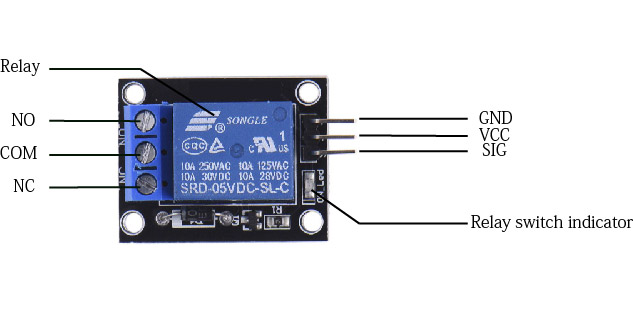Out Of Stock
Description
This is a 5V 1ch 10A relay interface board. It can be used to control a variety of high-current appliances and equipment. It has a standard interface that can be controlled directly by the microcontroller. blue terminal for easier high-current wiring, it can work with a High Trigger
Package Includes:
- 1 x 1 Channel 10A 5V High Trigger Relay Module
Features:
- Good in safety. In power systems and high voltage systems, the lower current can control the higher one.
- 1-channel high voltage system output, meeting the needs of single-channel control
- Wide range of controllable voltage.
- Being able to control high load current, which can reach 240V, 10A
- With a normally-open (NO) contact and a normally-closed (NC) contacts
Description:
This is a 5V 1ch 10A relay interface board. It can be used to control a variety of high-current appliances and equipment. It has a standard interface that can be controlled directly by the microcontroller. blue terminal for easier high-current wiring, it can work with a High Trigger. Safety features are provided by red working status indicator lights. MCU control, industrial sector control, PLC control, and intelligent home control are all common applications. it can work with a High Trigger It has a 1×3 (2.54mm pitch) pin header for connecting power (5V and 0V), and for controlling the relay. The pins are marked on the PCB.
Principle of Work:
An iron core is surrounded by a control coil. As shown, the power source is given to the electromagnet through a control switch and through contacts to the load. When current starts flowing through the control coil, the electromagnet starts energizing and thus intensifies the magnetic field. Thus the upper contact arm starts to be attracted to the lower fixed arm and thus closes the contacts causing a short circuit for the power to the load. On the other hand, if the relay was already de-energized when the contacts were closed, then the contact move oppositely and make an open circuit.
As soon as the coil current is off, the movable armature will be returned by a force back to its initial position. This force will be almost equal to half the strength of the magnetic force. This force is mainly provided by two factors. They are spring and also gravity.
Relays are mainly made for two basic operations. One is low voltage application and the other is high voltage. For low-voltage applications
Pinout of the Module:

- GND – Connect 0V to this pin.
- SIG – Controls this relay
- VCC – Connect 5V to this pin.
- COM- Common pin
- NC- Normally Closed, in which case NC is connected with COM when INT1 is set low and disconnected when INT1 is high
- NO- Normally Open, in which case NO is disconnected with COM1 when INT1 is set low and connected when INT1 is high
Applications:
- Relay Drive from External Contacts.
- LED Series and Parallel Connections.
- Electronic Circuit Drive by Means of a Relay.
- Home automation
- Battery backup
- High current load switching
Circuit:
1 distinct load has been connected to the relay NO terminal. the relay common terminal has a live wire connected to it. When the relay is activated, the load is powered and connected to the live wire. This configuration can be reversed by connecting the load to the NC terminal, which keeps the load powered on until the relay is activated. the relay is connected to pin 2 and the trigger is in a high configuration. the power source for the relay is external and the GND of the MCU is connected to the COM pin.

Library:
This Module doesn't need a library to work.
Code:
void setup() {
// initialize digital pin 2 as an output.
pinMode(2, OUTPUT);
}
// the loop function runs over and over again forever
void loop() {
digitalWrite(2, HIGH); // turn the LED ON by making the voltage HIGH delay(1000);
delay(1000); // wait for a second
digitalWrite(2, LOW); // turn the on off(LOW is the voltage level)
delay(1000); // wait for a second
}
Technical Details:
- 1 Channel
- Supply voltage: 5V
- Trigger mode: high trigger
- Voltage: DC 30V or AC 250V
- Current: 10A
- PCB Size:43 x 12 x 10mm
- Item Weight: 14g
Resources:
Comparisons:
This is an active high-triggered relay with no optocoupler good for the low price and easy to work with its similar to this item (Relay Module Board 1 Channel 5V High-Level Trigger) the only difference is the relay LED that lights up when the relay is one but doesn't forget for application on battery extra un needed LED's is just a waste of current, this relay module has no optocoupler which makes it exposed to some distortion from the AC side which can affect your microcontroller, we prefer using other modules on the website with optocouplers to work with MCU's like this item.
This kind of relay board has so many advantages like being able to withstand large inrush currents and high mechanical structure reliability, not being susceptible to the external electromagnetic environment, and being able to carry high voltage, and high current load but still, it has multiple disadvantages to the SSR Boards that they are slower than SSRs at 5 to 15ms and it has a larger package size, are not suitable for small projects and electromechanical relays tend to have a shorter life than other types of relays due to mechanical wear if you interested in SSRs you can get it from here